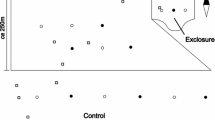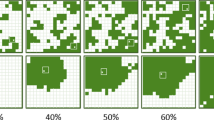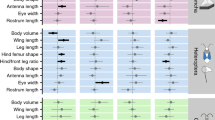Abstract
Several experimental studies have examined species responses to manipulations of habitat area and spatial arrangement, but plant composition and spatial variation in species distributions also affect animal responses to habitat alteration. We used an experimental approach to study the combined effects of habitat area, edge, and plant community composition on the spatial structure of insect species richness and composition. The abundance of three guilds (herbivores, predators and parasitoids) and individual species were also analyzed. Habitat patches were created that differed in area and edge by selectively mowing portions of 15 m×15 m plots in a 1.7-ha old field. Spatial and environmental variables were used to predict insect responses in separate multiple regression and ordination models. The variation in species responses due to spatial and environmental variables was then partitioned by combining these variables into an overall regression or ordination. Spatial and environmental variables contributed similar percentages to the total variance in insect species richness, abundance or composition. No significant effects of habitat area were observed in any response variable. Herbivore abundance showed positive responses to legume or grass cover, as well as spatial variation that was unrelated to environmental variables. Predators and parasitoids had greater effects of plant species richness and habitat edge, and less unexplained spatial variation. Individual species differed in their responses to plant variables, depending on host specialization or intraspecific aggregation. Our study highlights the importance of plant community composition and spatial variation apart from environmental variables. Spatial variation stems both from species responses to environmental features as well as species differences in habitat specialization and intraspecific aggregation.





Similar content being viewed by others
References
Andow DA (1991) Vegetational diversity and arthropod population response. Ann Rev Entomol 36:561–586
Andren H (1994) Effects of habitat fragmentation on birds and mammals in landscapes with different proportions of habitat: a review. Oikos 71:355–366
Bach CE (1988) Effects of host plant patch size on herbivore density: patterns. Ecology 69:1090–1102
Bascompte J, Solé RV (1996) Habitat fragmentation and extinction thresholds in spatially explicit models. J Anim Ecol 65:465–473
Borror DJ, Triplehorn CA, Johnson NF (1989) An introduction to the study of insects, 6th edn. Saunders College Publishing, Philadelphia
Borcard D, Legendre P (2002) All-scale spatial analysis of ecological data by means of principal coordinates of neighbour matrices. Ecol Mod 153:51–68
Borcard D, Legendre P, Drapeau P (1992) Partialling out the spatial component of ecological variation. Ecology 73:1045–1055
Borcard D, Legendre P, Avois-Jacquet C, Tuomisto H (2004) Dissecting the spatial structure of ecological data at multiple scales. Ecology 85:1826–1832
Burnham K, Anderson D (2002) Model selection and multimodel inference: a practical information-theoretical approach, 2nd edn. Springer, Berlin Heidelberg New York Tokyo
Collinge SK (2000) Effects of grassland fragmentation on insect species loss, colonization, and movement patterns. Ecology 81:2211–2226
Collinge SK, Palmer TM (2002) The influences of patch shape and boundary contrast on insect response to fragmentation in California grasslands. Land Ecol 17:629–636
Collins SL (1992) Fire frequency and community heterogeneity in tallgrass prairie vegetation. Ecology 73:2001–2006
Crist TO (1998) The spatial distribution of termites in shortgrass steppe: a geostatistical approach. Oecologia 114:410–416
Crist TO, Ahern RG (1999) Effects of patch size and temperature on the distribution and abundance of ground beetles (Coleoptera: Carabidae) in an old field. Environ Entomol 28:681–689
Davies KF, Margules CR (1998) Effects of habitat fragmentation on carabid beetles: experimental evidence. J Anim Ecol 67:460–471
Davies KF, Margules CR, Lawrence JF (2001) A synergistic effect puts rare, specialized species at greater risk of extinction. Ecology 85:265–271
Debinski DM, Holt RD (2000) A survey and overview of habitat fragmentation experiments. Cons Biol 14:342–355
Denno RF, McClure MS (eds) (1983) Variable plants and herbivores in natural and managed systems. Academic Press, New York
Fahrig L (2003) Effects of habitat fragmentation on biodiversity. Ann Rev Ecol Evol Syst 34:487–515
Fleischer SJ, Gaylor MJ (1988) Lygus lineolaris population dynamics, nymphal development, life tables and Leslie matrices on selected weeds and cotton. Environ Entomol 17:246–253
Fleishman E, Ray C, Sjögren-Gulve P, Boggs C, Murphy DD (2002) Assessing the roles of patch quality, area, and isolation in predicting metapopulation dynamics. Cons Biol 16:706–716
Golden DM, Crist TO (1999) Experimental effects of habitat fragmentation on old field canopy insects: community and guild species responses. Oecologia 118:371–380
Golden DM, Crist TO (2000) Experimental effects of habitat fragmentation on rove beetles and ants: patch area or edge? Oikos 90:525–538
Grez A, Zaviezo T, Tischendorf L, Fahrig L (2004) A transient positive effect of habitat fragmentation on insect population densities. Oecologia 141:444–451
Harmon JP, Hladilek EE, Hinton JL, Stodola TJ, Andow DJ (2003) Herbivore response to vegetational diversity: spatial interaction of resources and natural enemies. Popul Ecol 45:75–81
Hawkins C, MacMahon JA (1989) Guilds: the multiple meanings of a concept. Ann Rev Entomol 34:423–451
Haynes KJ, Cronin JT (2003) Matrix composition affects the spatial ecology of a prairie planthopper. Ecology 84:2856–2866
Kareiva P (1987) Habitat fragmentation and stability of predator-prey interactions. Nature 326:388–390
Kolasa J, Rollo CD (1991) Introduction: the heterogeneity of heterogeneity. In: Kolasa J, Pickett STA (eds) Ecological heterogeneity. Springer, Berlin Heidelberg New York Tokyo, pp 1–23
Krauss J, Klein AM, Steffan-Dewenter I, Tscharntke T (2003) Effects of habitat area, isolation, and landscape diversity on plant species richness of calcareous grasslands. Biodiv Cons 13:1427–1439
Legendre P, Legendre L (1998) Numerical ecology, 2nd edn. Elsevier, Amsterdam
Méot A, Legendre P, Borcard D (1998) Partialling out the spatial component of ecological variation: questions and propositions in the linear modelling framework. Environ Ecol Stat 5:1–27
Neter J, Wasserman W, Kutner MH (1990) Applied linear statistical models, 3rd edn. Irwin Inc, Burr Ridge
Robinson GR, Holt RD, Gaines MS, Hamburg SP, Johnson ML, Fitch HS, Martinko EA (1992) Diverse and contrasting effects of habitat fragmentation. Science 257:524–526
Roland J, Taylor PD (1997) Insect parasitoid species respond to forest structure at different spatial scales. Nature 386:710–713
Rutledge CE, O’Neil RJ, Fox TB, Landis DA (2004) Soybean aphid predators and their use in integrated pest management. Ann Entomol Soc Am 97:240–248
SAS Institute (2004) SAS for Windows, release 9.2. SAS Institute, Cary, N Carol
Scheiner SM, Gurevitch J (eds) (1993) Design and analysis of ecological experiments. Chapman & Hall, New York
Siemann E, Tilman D, Harstaad J, Ritchie M (1998) Experimental tests of the dependence of arthropod diversity on plant diversity. Am Nat 152:738–750
Stoner KJL, Joern A (2004) Landscape vs local habitat scale influences to insect communities from tallgrass prairie remnants. Ecol Appl 14:1306–1320
Summerville KS, Crist TO (2001) Effects of experimental habitat fragmentation on patch use by butterflies and skippers (Lepidoptera). Ecology 82:1360–1370
Summerville KS, Crist TO (2004) Contrasting effects of habitat quantity and quality on moth communities in fragmented landscapes. Ecography 27:3–12
ter Braak CJF (1995) Ordination. In: Jongman RHG, ter Braak CJF, van Tongeren OFR (eds) Data analysis in community and landscape ecology. Cambridge University Press, Cambridge, pp 91–173
ter Braak CJF, Šmilauer P (2002) CANOCO reference manual and CanoDraw for Windows user’s guide: software for canonical community ordination (ver 4.5). Microcomputer Power, Ithaca, NY
Thies C, Steffan-Dewenter I, Tscharntke T (2003) Effects of landscape context on herbivory and parasitism at different spatial scales. Oikos 101:18–25
Tscharntke T, Brandl R (2004) Plant-insect interactions in fragmented landscapes. Ann Rev Entomol 49:405–430
Wagner HH (2003) Spatial covariance in plant communities: integrating ordination, geostatistics, and variance testing. Ecology 84:1045–1057
Wiens JA, Stenseth NC, Van Horne B, Ims RA (1993) Ecological mechanisms and landscape ecology. Oikos 66:369–380
Wipfli MS, Wedgberg JL, Hogg DB, Syverud TD (1989) Insect pests associated with birdsfoot-trefoil, Lotus corniculatus, in Wisconsin. Great Lakes Entomol 22:25–33
With KA (1997) The application of neutral landscape models in conservation biology. Cons Biol 11:1069–1080
With KA, Crist TO (1995) Critical thresholds in species’ responses to landscape structure. Ecology 76:2446–2459
With KA, Pavuk DM, Worchuck JL, Oates RK, Fisher JL (2002) Threshold effects of landscape structure on biological control in agroecosystems. Ecol Appl 12:52–65
Young OP (1986) Host plants of the tarnished plant bug Lygus lineolaris. Ann Entomol Soc Am 79:747–762
Acknowledgements
We thank Kyle Haynes, Tim Diekötter, and two anonymous reviewers for providing helpful comments on earlier versions of the manuscript. The experiments conducted in this study were in compliance with the laws of the US and the State of Ohio.
Author information
Authors and Affiliations
Corresponding author
Additional information
Communicated by Richard Karban
Rights and permissions
About this article
Cite this article
Crist, T.O., Pradhan-Devare, S.V. & Summerville, K.S. Spatial variation in insect community and species responses to habitat loss and plant community composition. Oecologia 147, 510–521 (2006). https://doi.org/10.1007/s00442-005-0275-1
Received:
Accepted:
Published:
Issue Date:
DOI: https://doi.org/10.1007/s00442-005-0275-1




